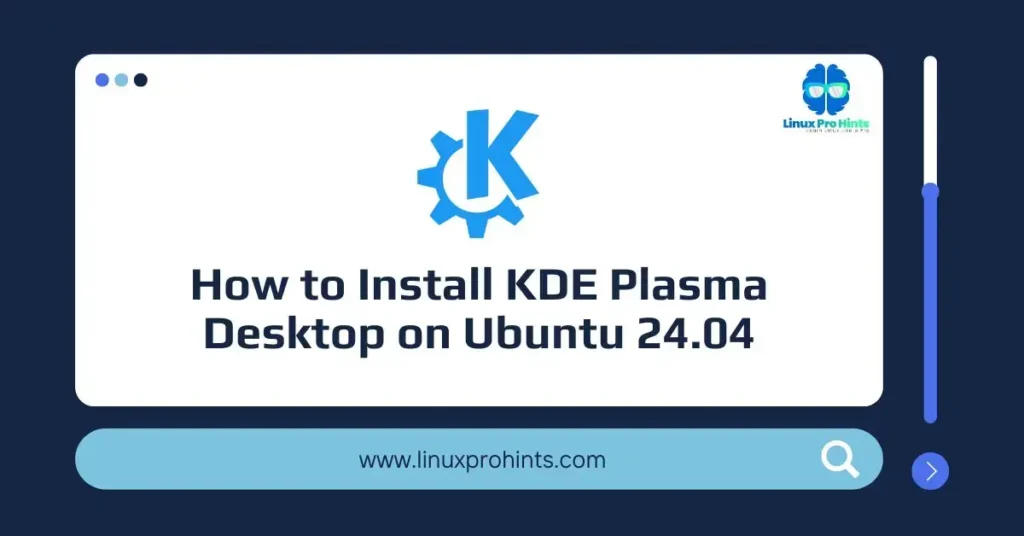Ubuntu 24.04 (Noble Numbat) is one of the most stable and widely used Linux distributions, often deployed in environments where a GUI is optional. If you installed Ubuntu without a graphical interface or want to replace the default GNOME desktop with a more customizable, modern, and responsive environment, the KDE Plasma Desktop is an excellent choice.
Known for its performance, elegant design, and extensive customization options, KDE Plasma provides a powerful desktop experience tailored to developers, professionals, and everyday users.
This guide explains how to install KDE Desktop on Ubuntu 24.04 using simple, reliable commands, complete with explanations and examples. After installation, your Ubuntu system will transform into a fully functional KDE Plasma Desktop.
Why Choose KDE Plasma on Ubuntu 24.04?
Before we proceed with the installation, it’s worth understanding what makes KDE Plasma a compelling choice:
- Unmatched Customization: Control every aspect of your desktop—from themes and widgets to window animations and panel behavior.
- Feature-Rich and Lightweight: KDE Plasma is surprisingly lightweight on system resources while offering a vast ecosystem of applications (like Dolphin file manager and Krita) through the KDE Frameworks.
- Activities and Virtual Desktops: Create multiple virtual desktops and distinct “Activities” tailored for different workflows (e.g., work, development, gaming) to boost productivity.
- Modern and Polished: The Plasma desktop offers a sleek, modern user interface that is both intuitive for beginners and deeply configurable for experts.
Prerequisites
- An Ubuntu 24.04 system with a user account having
sudoprivileges. - A stable internet connection to download the necessary packages.
- (Optional but recommended) A backup of your important data.
Install KDE Desktop Environment on Ubuntu 24.04
The installation process is straightforward and conducted entirely from the command line. We will use the official kubuntu-desktop package, which provides a complete and integrated KDE Plasma experience.
Step 1: Update Your System Package Index
First, ensure your system’s package list is up to date. This guarantees you are installing the latest available versions of all software.
Open your terminal (Ctrl + Alt + T) and execute:
sudo apt updateThe sudo apt update command fetches the latest list of available packages from the configured repositories. It does not install or upgrade any packages itself.
Step 2: Install the Kubuntu-Desktop Package
This is the core command that installs the KDE Plasma desktop environment along with a curated set of KDE applications and utilities.
Run the following command:
sudo apt install kubuntu-desktop kubuntu-settings-desktop -yWhat These Packages Do:
| Package | Description |
|---|---|
| kubuntu-desktop | Installs the full KDE Plasma desktop environment along with KDE apps such as Dolphin, Konsole, Discover, etc. |
| kubuntu-settings-desktop | Provides default Kubuntu layout, theme, and configuration settings. |
During the installation, you may encounter a configuration screen for SDDM (Simple Desktop Display Manager), which is the default login manager for KDE Plasma.
- If you are installing on a system without any existing GUI, the installer will typically configure SDDM automatically.
- If you are replacing an existing desktop (like GNOME’s GDM), you will be prompted to choose which display manager to use. Select
sddmand pressEnter. You can always reconfigure this later with thesudo dpkg-reconfigure sddmcommand.
The installation may take several minutes as it downloads and installs a significant number of packages.
Step 3: Reboot Your System to Load KDE Plasma
Once the installation completes successfully, you must reboot your system to load the new desktop environment and start the SDDM display manager.
sudo rebootThe reboot command cleanly shuts down all system processes and restarts the computer. Upon reboot, you will be greeted by the KDE Plasma login screen (SDDM).
Post-Installation: First Login and Selection
- On the SDDM login screen, you will typically find a session selector (often represented by a desktop icon or a menu button).
- Click this selector and ensure “Plasma” or “KDE Plasma” is chosen as your session type. This is crucial if you had another desktop environment installed previously.
- Log in with your username and password.
Congratulations! You will now be welcomed by the default KDE Plasma desktop on Ubuntu 24.04.
Troubleshooting and FAQs
What if I Want a Minimal KDE Installation?
If you prefer a bare-bones KDE Plasma setup without the additional applications from Kubuntu, you can install the plasma-desktop package instead. This is ideal for users who want to build their environment from the ground up.
sudo apt install plasma-desktopThis option provides a lightweight KDE experience, without additional KDE utilities.
How Do I Switch Back to GNOME (or Another Desktop)?
At the login screen (SDDM), simply use the session selector to choose “Ubuntu” (for GNOME) or another installed desktop environment before logging in. Your session choice is usually remembered for future logins.
How Do I Completely Remove KDE Plasma?
If you decide KDE Plasma is not for you, you can remove it. However, removing large meta-packages can be tricky. A safer approach is to use apt autoremove after removal to clean up unused dependencies.
sudo apt remove kubuntu-desktop
sudo apt autoremoveWarning: Be very careful with autoremove and review the list of packages it plans to remove to ensure nothing critical is included.
How to Remove GNOME (If I Want KDE Only)
(Do this only if you’re sure you don’t need GNOME anymore.)
sudo apt purge ubuntu-desktop gnome-shell -y
sudo apt autoremove --purge -yConclusion
By following this guide, you have successfully transformed your Ubuntu 24.04 system with the powerful and elegant KDE Plasma desktop environment. You now have access to a highly customizable platform that can be molded to fit your exact workflow and aesthetic preferences. Explore the System Settings, add widgets to your desktop and panels, and experiment with different Activities to unlock the full potential of your new desktop.
Enjoy your refreshed and more personalized Ubuntu experience with KDE Plasma!



